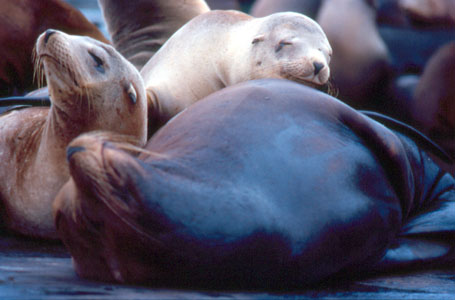In 1989, the Loma Prieta earthquake shook up San Francisco, taking down a portion of the Bay Bridge, disrupting game three of the historic "Battle of the Bay" World Series and causing $6 billion worth of damage throughout the Bay Area.

No one is quite sure why the sea lions decided to haul out on Pier 39ís K-Dock 23 years ago. The number of sea lions on the pier has fluctuated with no apparent rhyme or reason over the years from just a handful to several hundred at a time. Photo courtesy of Pier 39
By Mallory Johnson
Published: January, 2013
In 1989, the Loma Prieta earthquake shook up San Francisco, taking down a portion of the Bay Bridge, disrupting game three of the historic "Battle of the Bay" World Series and causing $6 billion worth of damage throughout the Bay Area.
A few months after the earthquake, locals started noticing another change near San Francisco’s waterfront—California sea lions began hauling out on Pier 39’s K-Dock. At first there were only a few of them, but after just a few months, there were over 300 energetic sea lions barking, bathing and playing on the dock. No one is quite sure why the sea lions decided to haul out on Pier 39, but these lively pinnipeds quickly became a huge sensation, bringing locals and tourists alike out to Pier 39 to observe them. While California sea lions have always been found in the Bay, their typical hangout before 1990 was on Seal Rock near Ocean Beach.
If you’ve ever walked along or near Pier 39, chances are you’ve heard them. The number of sea lions on the pier has constantly fluctuated with no apparent rhyme or reason. In November 2009, a record number of 1,701 sea lions visited K-Dock. One month later, their numbers dropped dramatically and only a handful were left.
You may have noticed the Pier 39 sea lions laying around in close bundles, almost on top of one another. This isn’t a problem of too many sea lions or a lack of space. Sea lions have an innate need, called thigmotaxis, to be in close contact with others. Sea lions are incredibly social animals and generally feel more secure when they are surrounded by others.
The overwhelming majority of the sea lions found on K-Dock are males. How can you tell? Males are much larger than females, boasting a thicker neck and protruding crest atop their heads. Males also have a darker hide, while females and juveniles come in a light brown or gray color.
So where are the ladies? Female sea lions typically stay around southern California, near the Channel Islands or off Mexico. During mating season, the males will migrate to them and win them over by establishing and defending a territory. The females will choose their mate by wandering throughout the territories, usually avoiding the males who are overly assertive or energetic. After the breeding season, the males will migrate back to northern California, and many of them will end up back at their home on Pier 39.
We may not know why the sea lions are here, but that doesn’t stop us from admiring and celebrating them. On January 18-21, Pier 39, Aquarium of the Bay and the Marine Mammal Center will join forces to celebrate the 23rd anniversary of the sea lions’ arrival to K-Dock. The public is invited to visit Pier 39 and take part in "Sea Lion Encounter," which consists of free 20-minute educational walking tours hosted by knowledgeable naturalists from Aquarium of the Bay and the Marine Mammal Center. Learn everything you ever wanted to know about California sea lions, marine life and Bay conservation while watching these delightful animals playing, barking and swimming along the docks.
Fun Facts About Sea Lions!
California sea lions are known for their intelligence, playfulness, and noisy barking!
Males reach 850 pounds (390 kg) and 7 feet (2.1 m) in length. Females grow to 220 pounds (110 kg) and up to 6 feet (1.8 m) in length.
You can tell males from females. Look for the bump or "crest" males develop on their heads starting when they’re four or five years old. PIER 39’s sea lions are mostly males.
Sea lions range along the Pacific coast from Vancouver to the southern tip of Baja, and most pups are born on the Channel Islands located off Southern California in June.
Since they’re animals of habit, it’s a good bet the sea lions will continue to return to PIER 39.
California sea lions are protected by the Marine Mammal Protection Act. It is unlawful for unauthorized persons to feed, handle or harass them.
Sea lions will bite if provoked.
Sea lions in the wild may live up to 20 – 25 years.
Sea Lions vs. Seals
Sea lions have large fore flippers that they use to propel themselves in the water and that enable them to walk on all fours on land.
Seals have very small fore flippers. They use their hind flippers to move through the water and crawl on land, relying on stomach muscles.
Sea lions have external ear flaps.
Seals have small bullet-like holes on the sides of their heads.
The pelage of sea lions is a solid color.
The pelage of a seal is often spotted.
Sea lions have smooth whiskers.
Seals have beaded or crimped whiskers.
For more information, visit www.pier39.com or www.aquariumofthebay.org.

Sea lions have an innate need to be in close contact with other sea lions, making them incredibly social animals that generally feel more secure when they are surrounded by others.

